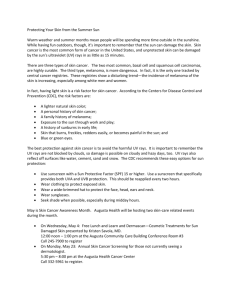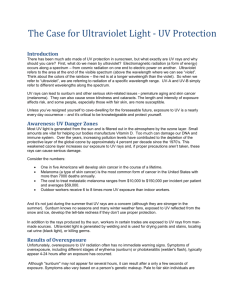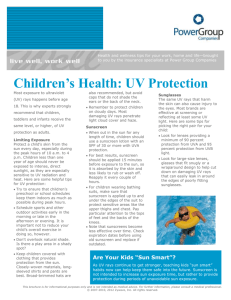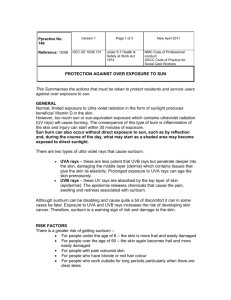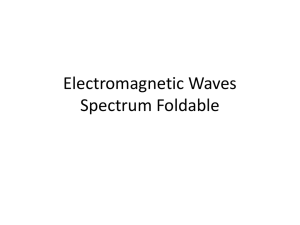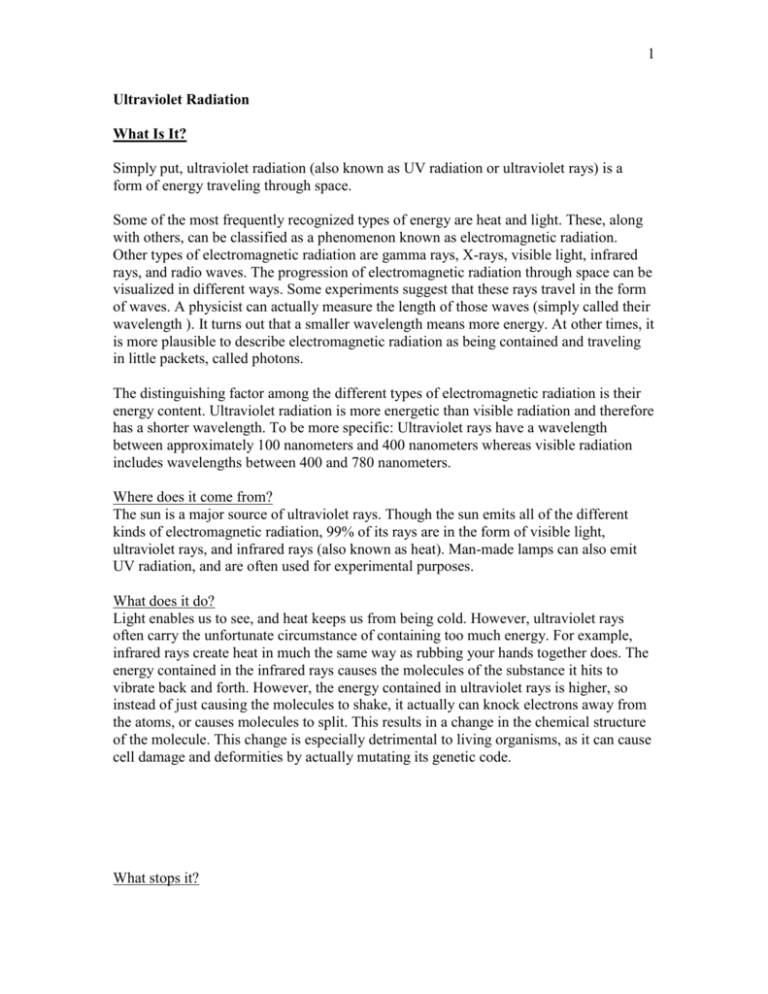
1
Ultraviolet Radiation
What Is It?
Simply put, ultraviolet radiation (also known as UV radiation or ultraviolet rays) is a
form of energy traveling through space.
Some of the most frequently recognized types of energy are heat and light. These, along
with others, can be classified as a phenomenon known as electromagnetic radiation.
Other types of electromagnetic radiation are gamma rays, X-rays, visible light, infrared
rays, and radio waves. The progression of electromagnetic radiation through space can be
visualized in different ways. Some experiments suggest that these rays travel in the form
of waves. A physicist can actually measure the length of those waves (simply called their
wavelength ). It turns out that a smaller wavelength means more energy. At other times, it
is more plausible to describe electromagnetic radiation as being contained and traveling
in little packets, called photons.
The distinguishing factor among the different types of electromagnetic radiation is their
energy content. Ultraviolet radiation is more energetic than visible radiation and therefore
has a shorter wavelength. To be more specific: Ultraviolet rays have a wavelength
between approximately 100 nanometers and 400 nanometers whereas visible radiation
includes wavelengths between 400 and 780 nanometers.
Where does it come from?
The sun is a major source of ultraviolet rays. Though the sun emits all of the different
kinds of electromagnetic radiation, 99% of its rays are in the form of visible light,
ultraviolet rays, and infrared rays (also known as heat). Man-made lamps can also emit
UV radiation, and are often used for experimental purposes.
What does it do?
Light enables us to see, and heat keeps us from being cold. However, ultraviolet rays
often carry the unfortunate circumstance of containing too much energy. For example,
infrared rays create heat in much the same way as rubbing your hands together does. The
energy contained in the infrared rays causes the molecules of the substance it hits to
vibrate back and forth. However, the energy contained in ultraviolet rays is higher, so
instead of just causing the molecules to shake, it actually can knock electrons away from
the atoms, or causes molecules to split. This results in a change in the chemical structure
of the molecule. This change is especially detrimental to living organisms, as it can cause
cell damage and deformities by actually mutating its genetic code.
What stops it?
2
Ultraviolet rays can be subdivided into three different wavelength bands—UV-A, UV-B,
and UV-C. This is simply a convenient way of classifying the rays based on the amount
of energy they contain and their effects on biological matter. UV-C is most energetic and
most harmful; UV-A is least energetic and least harmful.
Luckily,UV-C rays do not reach the earth’s surface because of the ozone layer. When
UV-C rays meet the ozone molecules at high layers of the atmosphere, the energy
inherent in them is enough to break apart the bond of the molecule and absorb the energy.
Therefore, no UV-C rays from the sun ever come into contact with life on earth, though
man-produced UV-C rays can be a hazard in certain professions, such as welders.
UV-B rays have a lower energy level and a longer wavelength than UV-C. As their
energy is often not sufficient to split an ozone molecule, some of them extend down to
the earth's surface. UV-A rays do not have enough energy to break apart the bonds of the
ozone, so UV-A radiation passes the earth's atmosphere almost unfiltered. As both UV-B
and UV-A rays can be detrimental to our health, it is important that we protect ourselves.
This can be done through a variety of ways. The most obvious is to reduce the amount of
time one spends in the sun, particularly between the hours of 11 am and 3 pm, when the
sun is at its highest in the sky. However, especially during the summer holidays, this does
not always work out. More ways to protect ourselves can be found here.
Variability of UV
UV levels are not constant over the course of a day, or even over the course of a year. An
obvious factor is the position of the sun in the sky. At noon, for example, the
electromagnetic waves emitted from the sun travel a much shorter path through the
earth’s atmosphere then they would at, say, 5 pm, and thus noon-time intensity is
stronger. A second important parameter determining UV at the ground is the amount of
ozone present in the stratosphere. Low ozone correlates with much UV. However, there
are many other features of the environment that contribute to UV radiation variability.
Most important are clouds. On cloudy days, UV levels are usually lower than during clear
skies as clouds can deflect rays up into space. Clouds can, however, also lead to increased
UV levels. This happens, for example, when the sun is not obscured by clouds but clouds
in the vicinity of the sun reflect additional radiation to the ground. So a general rule is not
to feel save from UV radiation just because it's cloudy!
The amounts of UV one is exposed to also varies with altitude. As a rule of thumb, UV
levels increase about 4% for every 1,000 foot gain in altitude. This increase has nothing
to do with being closer to the sun—any elevation you might gain would be miniscule in
comparison to the distance from the earth to the sun, and so would have an insignificant
outcome on UV levels. Instead, the increase is the result of a thinner atmosphere with a
smaller number of molecules being present to absorb or scatter UV. Examples of such
molecules are tropospheric ozone (commonly associated with smog) and aerosols,
molecules that remain suspended in the air. Aerosols can be a multitude of substances—
dust, soot, sulfates, etc. These aerosols absorb and scatter UV rays, and so cut down on
the ultimate UV irradiance.
3
Other factors that have an influence on UV levels are the physical features of the land—
sand, snow, and water all tend to reflect UV rays. This phenomenon is called albedo.
Some of the ultraviolet rays reflected off the ground encounter scattering by air
molecules, aerosols or clouds back down to the earth, thus increasing the total irradiance.
When there is snow on the ground the amount of time it takes for sunburn to occur is
therefore significantly reduced.
Also, the closer one is to the equator, the more ultraviolet rays one is exposed to. This can
be explained by the fact that the sun is usually higher at the sky at low latitudes. In
addition, the ozone layer is thinner at the equator as it is over, for example the United
States or Europe, and this also contributes to more UV.
Since the 1980s, polar regions are affected by the ozone hole. Under the ozone hole,
biologically relevant UV levels are 2-3 times as high as they were before. Learn, based
on real data, how UV levels are affected by the ozone hole by going to the experiments
page! Here you can compare UV radiation measured by the NSF network in Antarctica
with satellite ozone data.
Effects of UV Radiation on You
Positive effects
Ultraviolet rays have their place in our ecosystem, (and it isn’t merely to provide
manufacturers an opportunity to sell their sunscreens). UV rays, for example, are
necessary for our body to produce vitamin D, a substance that helps strengthen bones and
safeguards against diseases such as Rickets. Some scientists have shown that Vitamin D
lowers the risk of getting some kinds of internal cancer, like colon cancer.
UV light is also used as a therapy for psoriasis, a condition in which the skin sheds its
cells too quickly, resulting in itchy, scaly patches on various parts of the body. When
exposed to ultraviolet rays, the growth of the skin cells is slowed, relieving the
symptoms.
UV rays are also used in various commercial functions, such as disinfecting fish tanks
and sterilizing medical equipment. Animal life makes their own use of these wavelengths
too—certain animals can actually see ultraviolet light, and use it to their advantage. Bees
use the reflection of UV off of flower petals to guide their pollen collecting. More effects
of UV on plants and animals can be found here.
Negative effects
Though ultraviolet rays do have a purpose, one must not use this information as a
validation for their sunbathing habits. The dangers of UV exposure are real, and public
ignorance concerning these matters could lead to increased health problems in the future.
Skin
One of the most common effects of UV exposure is "erythema", also known as sunburn.
Sunburn occurs when skin cells are damaged by the absorption of energy from UV rays.
4
To compensate for this injury, the skin sends extra blood to the damaged skin in an
attempt to repair it—thus accounting for the redness that is associated with sunburn. The
amount of time it takes for a sunburn to occur is dependent mostly on the relative
amounts of UV rays that are hitting the skin, and on a person’s skin type. People with
naturally dark skin already have inherently high levels of melanin, and so are able to
spend a longer amount of time in the sun before burning, if they burn at all. Fair-skinned
people don’t have it quite so easy—burning can occur within a relatively short amount of
time.
Another effect of ultraviolet rays on the skin is photoaging. Recent studies have shown
that many of the symptoms commonly associated with mere aging (i.e. wrinkles,
loosening of the skin) may instead be related to UV exposure—so though your tan may
look good now, you could be paying your dues in wrinkles later.
The UV Index
In order to inform the public about the intensity of UV radiation the UV Index was
invented and is now published in newspapers and on TV. The definition of the UV Index
is the same throughout the world, so it's a great way to learn about the UV hazards at
your travel destinations. The Index is a simple number. 1-3 means low exposure; 4-6
means medium; 7-9 means high; and more than 10 means extreme exposure. The time
you can stay outside in the sun at a given UV Index depends also on on your skin type.
For example, if you have fair skin (Skin type I) and the UV Index is seven, it takes less
than 20 minutes until your skins starts to redden. If you have a dark skin color the same
UV level may need more than 40 minutes to cause an effect. Check out the noontime UV
Index at San Diego measured by the NSF network! During summer it is typically 10—
this means extreme. So know how to protect yourself!
Skin Cancer
A common misconception among the public is that if the damage isn’t visible, no damage
has been done. The only way to dispute this is to observe the long term effects of a
stimulus. One of these effects has been identified to be skin cancer. The American Cancer
Society has predicted that in the year 2001, approximately one million new cases of nonmelanoma type skin cancers will be diagnosed, along with an additional 51,400
melanoma cases. It is also predicted that in this same year, 7,800 people will die from
melanoma, and 2,000 people will die from other skin cancers (i.e. squamous and basal
cell carcinoma). What is the significance of this? Skin cancer rates have been on the rise
in the United States since the 1970’s, with melanoma incidences increasing at a rate of
6% a year until 1981. Since then, the melanoma incidence rate has increased steadily at a
3% increase a year. (Statistics taken from The American Cancer Society Statistics Page at
www.cancer.org) These increasing rates mean that the threat of cancer has become a
personal issue to the average American. Luckily, it is believed that the causes of the
majority of skin cancers have been identified—ultraviolet radiation.
Basal and squamous cell carcinoma
There are three basic types of skin cancer: melanoma, basal cell carcinoma, and
squamous cell carcinoma. Basal and squamous cell carcinoma make up the most common
5
and less dangerous forms, called non-melanoma cancers. It is believed that ultraviolet
rays (specifically UV-B) are one of the chief causes in these two cancers. In order to
understand why, it is helpful to know that cancers occur when mutated or damaged cells
in the body begin to divide and invade other areas, forcing out the healthy cells and
tissues. In the case of skin cancer, the ultraviolet rays from the sun are usually the
instigator. Researchers whose work is specifically geared towards squamous and basal
cancers have isolated the gene suspected of being mutated, namely the p53 gene. Under
normal circumstances, this gene works against cancerous tumors, inhibiting the division
of cells that have been mutated or damaged. If the cell cannot be repaired, the p53 gene
induces the cell to destroy itself, or commit “cellular suicide”, so that its mistakes cannot
be passed on to another cell during division. If the p53 gene is mutated, however, (for
example through UV-B rays) then it will prohibit a damaged cell from committing
suicide, thus leaving it available to divide as normal. The damaged cells then begin to
replace the healthy cells, and the condition known as cancer is developed. These types of
cancers, though common, are not usually fatal, as they rarely metastasize (extend to other
parts of the body).
Malignant melanoma
The causes of malignant melanoma are much less defined. Some suspect that there is a
relationship between UV exposure and melanoma rates, but there are varying theories.
(If you want to learn more how scientists come to a conclusion whether a theory is right
or wrong, click here!)
Some scientists have developed a theory that UV-A radiation is much more effective in
causing melanoma than assumed previously. If this were the case, then many sunscreens
currently available offer only very little protection against melanoma, as they mostly
block UV-B, and not UV-A. This would be a possible explanation for the observed trend
in melanoma cases, where incidences are more prevalent among the fair-skinned
population who use sunscreen than among the darker skinned, or even among the fairskinned who don’t use sunscreen. An explanation for this lies in the nature of
sunscreen—it blocks the UV-B rays that cause sunburn, thus allowing those of fair skin
to stay outside for longer amounts of time and still feel "safe". Instead, they are exposing
themselves to greater quantities of UV-A rays, which could be increasing their risk of
melanoma. The danger to sunscreen could also be two-fold—not only does it persuade
people to stay in the sun longer, but habitual sunscreen users tend to lack tans, which is
the body’s natural protection against both UV-A and UV-B. This allows even more UVA to penetrate the skin. The moral to this story? Don't rely exclusively on sunscreens as
your UV protection. Block also UV-A radiation by wearing hats and appropriate clothing.
How to identify Melanoma?
One of the best ways to protect against the dangers of melanoma is to catch it before it’s
too late. Melanoma has a high cure rate if it is caught early on. A simple way to
determine if a growth of a mole is dangerous is to check the ABC’s:
A—Asymmetry. Does one half of the mole look like the other?
6
B—Border Irregularity. Are the edges smooth and regular, or are they crooked?
C—Color. Is the color uneven?
D—Diameter. Is it larger than one cm?
Moles that develop later in life should also be a source of concern. Most benign moles
have been present since childhood. However, it is possible for childhood moles to
become malignant. Because of this, changes in the appearance of any mole should be
noted.
Effects on eyes
Ultraviolet rays can be reflected towards the eyes by certain substances, such as sand and
snow. When this happens, the amount of UV rays the eyes are exposed to is increased.
This fact is the basis of the condition photokeratitis, also known as snow blindness.
Photokeratitis is a sunburn of the cornea, and usually recedes within one to two days. It
occurs when the eyes are exposed to large quantities of UV light in a short amount of
time. The reflection of UV rays off of snow and sand are enough to incur this injury.
It is more difficult to isolate the exact amount of damage that UV imposes on the eye
over a long period of time, as the body has its own built-in defense against harmful rays.
If you were to try to look up at the sun, you would find that you would not be able to do
so for any length of time. Your eyes would naturally start to close. This effect is also
noticed on especially bright days, displayed in the form of squinting. What is known,
however, is that cumulative exposure to UV rays is one of the causes of opacity of the
eye's lens, called cataract, a condition that displays itself primarily in elderly people, and
results in blurred and fuzzy vision.
Ways to Protect Yourself
How to protect your skin
Sun burning is not a pleasant experience. Fortunately, we have ways to prevent it.
Avoiding the sun between the hours of 11 am and 3 pm during day light saving time can
reduce your UV exposure by more than 50%. If you have to be outside during these
hours, seek shade, wear T-shirts on the beach, hats with a broad brim, and sunglasses, and
apply sunscreen of a Sun Protection Factor of at least 15 to all parts of your body that are
not protected otherwise.
How do sunscreens work?
A sunscreen works in one of two ways; it either scatters oncoming UV rays away from
the skin (physical sunscreen) or it absorbs the UV rays before they can reach the skin
(chemical sunscreen). Both methods are effective, though chemical sunscreens tend to
only block UV-B, which is mostly responsible for sunburns. Sunscreens that block out
both UV-A and UV-B rays, with an SPF of at least 15 (SPF 30 is better) are preferable.
They should especially be applied between the hours of 11 and 3, when the amount of
UV rays hitting the earth is generally the greatest.
7
In order to allow the sunscreen to achieve its maximum protection, the sunscreen should
be applied about 20 minutes before you head out into the sun. If your intended activity
includes swimming or other water-related events, a waterproof sunscreen is best. It
should be noted, however, that no sunscreen is completely water or sweat proof.
Therefore, more sunscreen needs to be applied after any activity in which these factors
are involved.It should not be assumed,however, that applying sunscreen allows you to
safely stay out longer in the sun. Sunburn is the body’s natural warning sign—eliminating
the warning sign does not mean that you have eliminated all of the danger.
What is SPF?
SPF stands for Sun Protection Factor. It is the rating that the U.S. Food and Drug
Administration (FDA) puts on sunscreens that describes how much they extend the time
you can stay in the sun without getting sunburned. For example, if you can normally stay
outside for about 15 minutes before you start to burn, then applying a sunscreen with an
SPF of 20 allows you to stay out for 20 times 15 minutes before burning—or rather, 300
minutes. (Of course, that’s assuming you apply the right amount and none of it comes off
during your day.)
How to protect your eyes
The protection of the eyes from UV rays is actually very simple. Sunglasses with at least
99% UV-A and UV-B blockage do an effective screening job, especially if they wrap
around the head. This prevents UV rays from entering from the side. Check the label of
your sun glasses when you buy new ones! Does it say that it blocks UV? Older glasses
often did not absorb enough UV. If this is the case they may be doing more harm than
good. The dark tint of the sunglasses causes the pupils to widen in order to let in more
light. If sunglasses are only dark in the visible but not in the UV, actually more UV could
penetrate the eyes.
I want a tan, not a sunburn!
First keep in mind that there is no scientific evidence that a tan does any good for your
skin. If you still can't withstand the appeal of a bronze-colored appearance, sunbathe
responsibly and always avoid over-exposure. Spend small amounts of time in the sun
over a period of several days, to give your skin time to start its own built-in protection
against UV rays, for example the production of a substance called "melanin". Never risk
a sunburn. In addition to itching and skin damage that sunburn creates, sunburned skin
will soon shed, and with it goes much of the bronze tan.
Copyright © 1997-2001 by Biospherical Instruments Inc.
All rights reserved. All specifications subject to change without notice.

